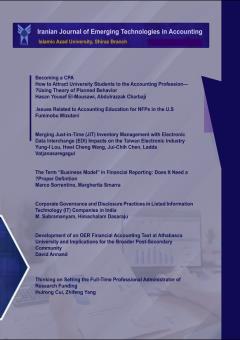Performance Evaluation of Different Districts of the Shiraz City Municipality Using DEA based on financial indicators
Subject Areas : • Other research topics related to emerging technologies in accounting, auditing and financeJavad Gerami 1 * , Majid Sajjadi 2
1 - Financial and economic assistant, Shiraz Municipality, Shiraz, Iran
2 - Department of Accounting, Shiraz Municipality, Shiraz, Iran.
Keywords: Data Envelopment Analysis, Efficiency, Ranking, Municipality,
Abstract :
Objectives: The purpose of this research is to evaluate and rank the performance of various districts within the Shiraz municipality based on different financial criteria. Therefore, we evaluated the performance of 11 districts of Shiraz municipality in the second half of 2022. Design/methodology/approach: Efficiency values were obtained for the areas using different technologies, and a suitable model was provided for the ineffective areas. The evaluation of the districts was based on input variables such as the number of employees, the area (in square meters) of the district building, and deferred income, as well as output variables including sold bonds, tax income, service income, and construction income. Input and output values were determined by consulting the informatics department of each district. Results: Based on the results, optimal performance recommendations can be made to senior managers of the municipality. Innovation: The current research is focused on evaluating financial aspect of performance in various districts of Shiraz Municipality. The goal is to find a suitable model for ranking these areas. This research can provide researchers and managers with an innovative perspective that can be applied in both theory and practice.
Barakpour, N., Goharipour, H., and Karimi, M., (2010). Evaluation of the performance of municipalities based on the measurement of people's satisfaction with municipal services (case example: Districts 1 and 11 of Tehran). Urban Management, 8(25), 203-218.
Razovian, M. T., Qadermarzi, H., Alian, M., Cheraghi, R, (2014). Urban management research strategy for sustainable development in historical contexts, a case study: the historical context of Yazd city, Urban and Regional Development Planning Quarterly, 1(1), 24-28.
Faraji, A., Adinevand, A. A., Alian, M., (2017). Evaluation of the performance of the municipalities of the eight regions of Ahvaz city in the framework of the good urban governance model", Urban and Regional Development Planning Quarterly, 3(5), 115–142.
Mousavi, M., (2016). Designing a performance evaluation model for urban management subordinate organizations using the development of a balanced scorecard (Mashhad municipality case study), Government Organizations Management, 14(2), 117–97.
Charnes A, Cooper WW, Rhodes E., (1978). Measuring the efficiency of decision-making units, European Journal of Operational Research, 2, 429–44.
Amiri, H., (2001). Investigating and determining the efficiency of municipalities in Iran. Master's thesis, University of Tehran.
Hadian, E., Azimi Hosseini, A., (2013). Calculating the efficiency of the banking system in Iran using the comprehensive data analysis method, Iranian Economic Studies Quarterly, 6(20), 1–20.
Levine, R., Smith, B. D., (2001). The impact of inflation on financial sector performance. Monetary Economics. 47(2), 221-248.
Secme, N., Yalcin, B., Kahraman, A., (2009). Fuzzy the financial performance evaluation in the Turkish banking sector using the analytic hierarchy process and Topsis, Expert Systems with Applications 36, 11699-11709.
Rogge, N., De Jaeger, S. (2012). Evaluating the efficiency of municipalities in collecting and processing municipal solid waste: A shared input DEA-model, Waste Management, 32, 1968–1978.
Worthington, A.C., Dollery, B.E., (2001). Measuring efficiency in local government: an analysis of New South Wales municipalities’ domestic waste management function. Policy Studies Journal, 29, 232–249.
Yang, Q., Wan, X., and Ma, H., (2015). Assessing the Green Development Efficiency of Municipalities and Provinces in China: Integrating Models of Super-Efficiency DEA and Malmquist Index, Sustainability, 7, 449–4510.
Andersen, P., Petersen, N.C., (1993). A procedure for ranking efficient units in data envelopment analysis. Management Science, 39, 1261–1264.

